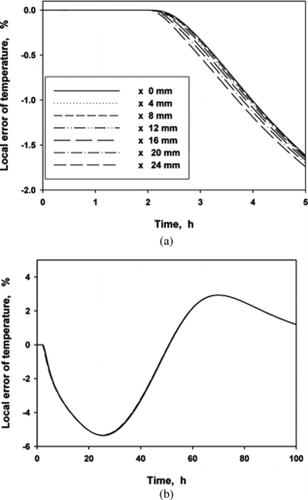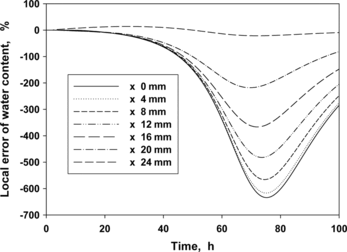The following text provides errata for the publication noted below.
Białobrzewski, I. Simultaneous heat and mass transfer in shrinkable apple slab during drying. Drying Technology 2006, 24 (5), 551–559.
The author and editors regret any inconvenience caused.
Influence of Shrinkage
The influence of shrinkage on the simulated apple drying process is presented in Figs. and . Figure allows concluding that consideration of shrinkage influenced the temperature in material profiles was significant but not in all the scope. The maximum err value was 5% (i.e., ca. 4°C). Figure shows that for the first 5 h of process non-consideration of shrinkage leads to larger errors in points more distant from the dried body surface. The generally negative err values indicate that when shrinkage was not considered, the predicted temperature values were higher. Figure shows that consideration of shrinkage has a major influence on water content in the moisture profile. The err values close to zero were recorded on sample surface at the beginning and at the end of process only. The RMS value on the sample surface was 13%. The RMS values in points with coordinate x = 0, 0.004, 0.008, 0.0012, 0.016, and 0.020 m were 329, 320, 295, 254, 196, and 119%, respectively. That indicates that generally non-consideration of shrinkage leads to larger errors in points more distant from the drying body surface, but for the first 20 h the error on the sample surface was greater. The negative values of the local error of water content indicate that inside the sample when shrinkage is not considered, the simulated water content values are higher. That results from the fact that if we do not consider shrinkage, the diffusion path of particles is much longer and, as a consequence, the time a water particle needs to leave the material is longer. At the surface the maximum absolute value of error was 21%. For low water content in sample, the values of the local error were very high, reaching the maximum absolute value of ca. 640%.
CONCLUSIONS
The article presents results of a simulation study of the simultaneous heat and mass transfer in the material considering the influence of drying-induced shrinkage. This study was carried out using the numerical solution of a system of three linked equations. The Arbitrary Lagrange-Eulerian (ALE) method was used to arrive at a problem with moving boundaries. Drying-induced shrinkage has major influence on the predicted water content. The results also suggest significant, but not in all cases, influence on the simulated temperature in the material values. The maximum err values were 54 and 640% for simulated average water contents in the samples: 2.240 and 0.126 kg kg−1, respectively. For those water content values the shrinkage was 32 and 45%, respectively. For the drying time of 100 h the shrinkage was 63%. The RMS value on the sample surface was 13% for water content. The RMS values in points with coordinate x = 0, 0.004, 0.008, 0.0012, 0.016, and 0.020 m were 329, 320, 295, 254, 196, and 119%, respectively. That indicates that generally non-consideration of shrinkage leads to larger errors in points more distant from the surfaces of heat and mass exchange with the surrounding, but for the first 20 h the error on sample surface was greater. The influence of shrinkage on the simulated temperatures in sample profiles was a large number less but significant too. The maximum err value was equal to 5% (i.e., ca. 4°C). The difference of temperatures between the sample center point and its surface of ca. 3.0°C was maintained only during the first hour of the process. That might result from the assumed literature model of the thermal conductivity coefficient.
Proof:
Here the subscript m refers to the material.
In Table 1, the third equation under “Parameters of air” should be:

